Étiquette : Beethoven
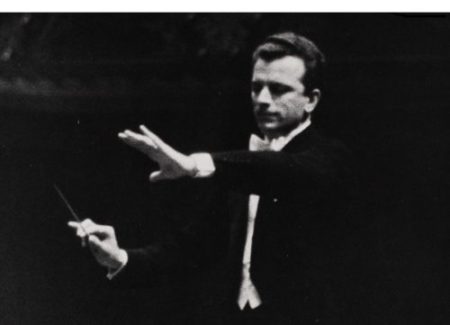
Guido Cantelli – Beethoven
Concerto n°3 Op.37 – Rudolf Firkušný, piano (Steinway) NYPO
Carnegie Hall – March 13, 1955
__________
Symphony n°1 Op. 21 – NBC SO
Carnegie Hall – January 10, 1954
Source: Bande/Tape 19 cm/s / 7.5 ips
Au cours des années cinquante, Firkušný était invité tous les ans à jouer avec le NYPO. En 1955, le choix se porta sur ce concerto de Beethoven, sous la direction de Cantelli. Les critiques du concert du 10 mars ont souligné la qualité de l’interprétation et l’entente entre le soliste et le chef.
Musical America: M. Firkušný et le chef d’orchestre étaient en parfait accord, ce qui a donné lieu à une interprétation bien intégrée. Bien qu’il ait semblé tendu, le pianiste a joué avec sa maîtrise technique habituelle et son tempérament sensible. Le soliste et l’orchestre ont apporté la même éloquence à la musique ».
New York Times: Dans le concerto de Beethoven, M. Cantelli s’est révélé être le plus sympathique et le plus attentif des accompagnateurs. Il a très bien travaillé avec M. Firkušný, et c’était un plaisir d’écouter les attaques et les relâchements tranchants. Le pianiste a joué magnifiquement, en prodiguant des détails d’écriture, en épurant ses phrases et en exécutant l’écriture avec netteté. Ce fut une interprétation élégante de la part de tous les participants, qui a fait ressortir la force et la poésie de la musique sans jamais commettre l’erreur de concevoir le Concerto en do mineur comme l' »Empereur ».
Cantelli a très peu dirigé la Première Symphonie de Beethoven. Son interprétation avec le NBC SO est une réussite et la source utilisée (une bande magnétique) est meilleure que celles des éditions précédentes.
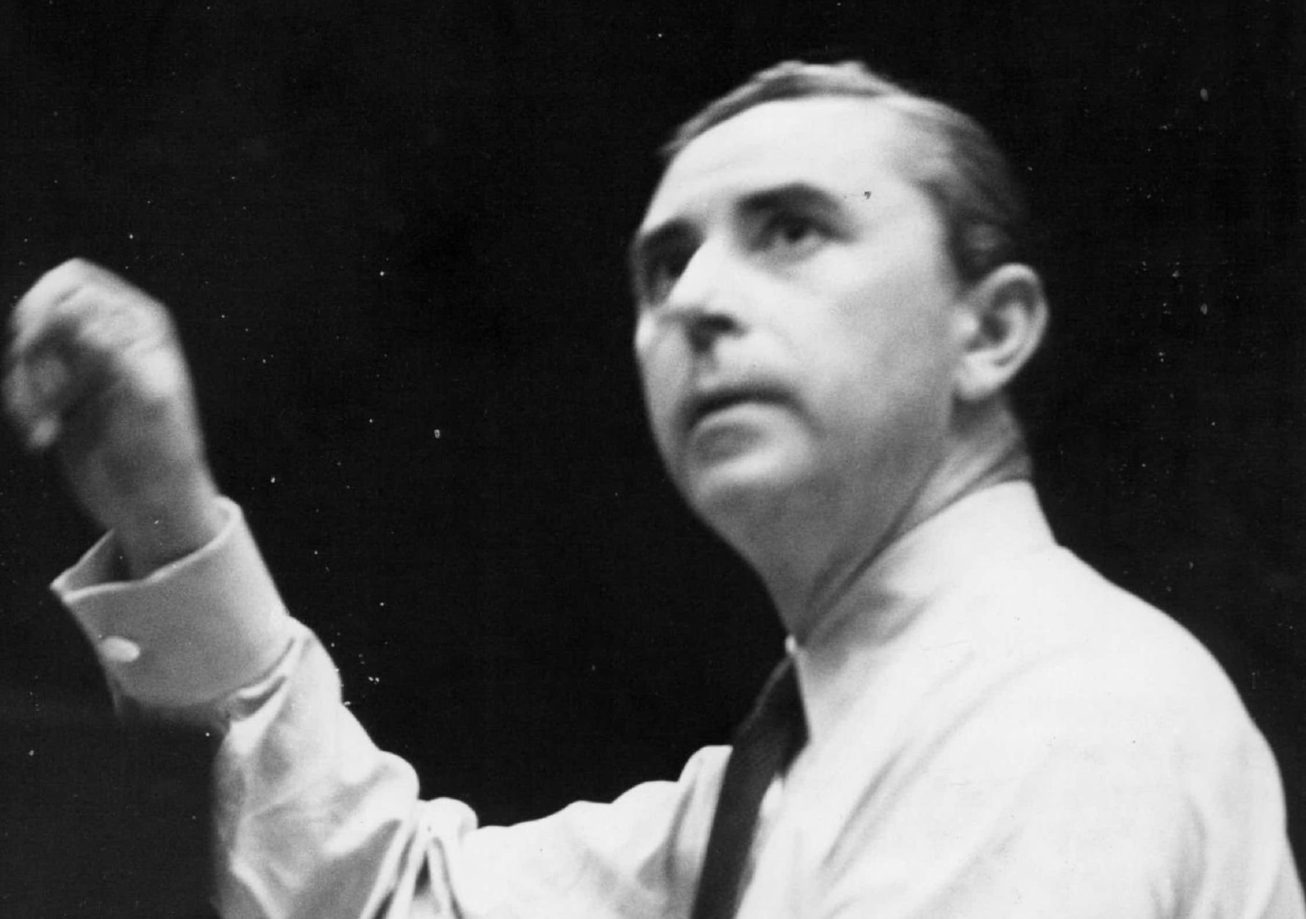

During the 1950s, Firkušný was invited every year to play with the NYPO. In 1955, the choice fell on this Beethoven concerto, conducted by Cantelli. Reviews of the March 10 concert praised the quality of the interpretation and the understanding between soloist and conductor.
Musical America: ‘Mr. Firkušný and the conductor saw eye to eye, and the result was a well-integrated performance. Although he seemed tense, the pianist played with his accustomed technical mastery and sensitivity of temperament. Soloist and orchestra brought equal eloquence to the music’.
New York Times: ‘In the Beethoven concerto, Mr. Cantelli proved to be the most sympathetic and careful of accompanists. He worked exceedingly well with Mr. Firkušný, and it was a pleasure to listen to the sharp attacks and releases. The pianist played beautifully, lavishing detail upon the writing, purling his phrases, bringing clean-cut execution of the writing. It was an elegant performance from all concerned, one that brought out the strength and poetry of the music without ever making the mistake of conceiving the C minor Concerto as the ‘Emperor’ ‘.
Cantelli has rarely conducted Beethoven’s First Symphony. His performance with the NBC SO is a success, and the source used (a magnetic tape) is better than those for previous editions.

Bach Sonate n°1 BWV 1001: II Fuga – III Siciliana – IV Presto Adolf Busch, Violin – 18 January 1934
____________
Concerto n°2 BWV 1042: III Allegro assai Adolf Busch, Violin – 29 November 1934
Beethoven Concerto n°4 Op58: I Allegro moderato Rudolf Serkin, piano – 23 February 1933
Fritz Busch Radio Symfoniorkestret (Danish Radio Orchestra)
Source: Bande/Tape 38 cm/s / 15 ips
Ces enregistrements de la Radio Danoise montrent trop brièvement Adolf Busch et Rudolf Serkin sous la direction de Fritz Busch, et Adolf Busch en soliste dans une Sonate de Bach dont il manque malheureusement le premier mouvement. Dans le premier mouvement du concerto de Beethoven, Rudolf Serkin et Fritz Busch se montrent ici bien meilleurs que dans l’enregistrement de concert de Serkin avec Toscanini (NBC SO – 26 novembre 1944).
La Radio Danoise disposait de deux platines Neumann et de supports de gravure directe de très grande qualité, d’où un rendu sonore étonnant pour des captations radiophoniques en public du milieu années trente, dont les CD Danacord, beaucoup trop filtrés ne sont qu’un pâle reflet. Le caractère parcellaire des enregistrements conservés provient du fait que la Radio n’avait pas de possibilité contractuelle de réaliser des archives des concerts diffusés en direct. Ces brefs regards sur ces artistes en concert publics n’en sont que plus précieux.
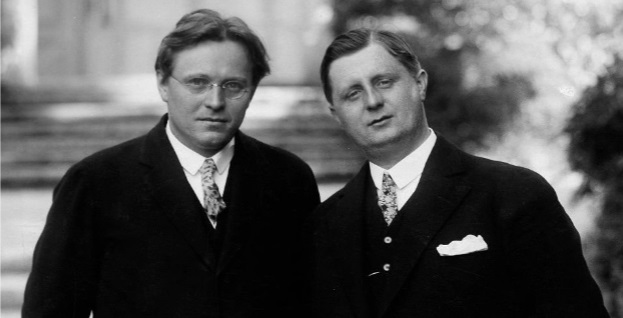
Adolf & Fritz Busch 1931

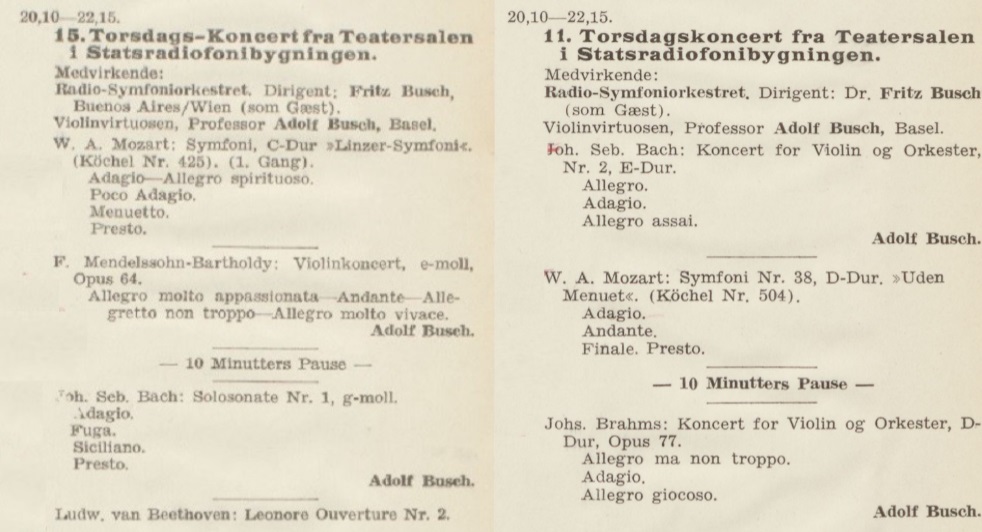

These Danish Radio recordings show Adolf Busch and Rudolf Serkin too briefly under the direction of Fritz Busch, and Adolf Busch as soloist in a Bach Sonata, the first movement of which is unfortunately missing. In the first movement of the Beethoven concerto, Rudolf Serkin and Fritz Busch are much better than in Serkin’s concert recording with Toscanini (NBC SO – 26 November 1944).
The Danish Radio had two Neumann turntables and very high quality direct recording media, resulting in an astonishing sound rendition for broadcast live recordings from the mid-thirties, of which the Danacord CDs, much too filtered, are only a pale reflection. The fragmentary nature of the preserved recordings comes from the fact that the Radio had no contractual possibility of making archives of the concerts broadcast live. These brief glimpses of these artists in public concerts are all the more precious.

Fritz Busch – Radio Symfoniorkestret Statsradiofoniens Kor
Orchestre et Chœurs de la Radio Danoise / Danish Radio Orchestra and Choir
Copenhagen Odd Fellow Palæet
Source: Bandes 38 cm/s / 15 ips Tapes
Haydn Die Schöpfung Hob. XXI:2 – Part II:
Erna Berger, soprano; Julius Patzak, tenor; Alexander Kipnis, Bass – 6 December 1934
n°14 ‘Und Gott sprach’ & n°15 Arie ‘Auf starkem Fittiche’ Erna Berger
n°20 ‘Und Gott sprach’ & n°21 ‘Gleich öffnet sich der Erde Schoss’ Alexander Kipnis
n°23 ‘Und Gott schuf den Menschen’ & n°24 Arie ‘Mit Würd und Hoheit angetan’ Julius Patzak
n°28 Chor ‘Vollendet ist das grosse Werk’*
*inédit/never published before in any format
______________
Beethoven: Erika Rokyta, soprano; Ingeborg Steffensen, mezzo; Koloman von Pataky, tenor; Alexander Kipnis, bass
Missa Solemnis Op.123 Sanctus – 14 February 1935
Symphonie n°9 Op.125- IV Presto – Allegro assai – Presto – 12 April 1934**
** Report, Montage et ‘Mastering’ / Transfer, Editing and Mastering: Charles Eddi
Alexander Kipnis et Fritz Busch se sont produits ensemble à de nombreuses reprises, comme ici à la Radio Danoise, mais aussi au Teatro Colón de Buenos-Aires, notamment Mozart Don Giovanni (Commendatore), Strauss Arabella (Graf Waldner), Rosenkavalier (Ochs), Wagner Fliegende Hollander (Daland), Götterdämmerung (Hagen), Lohengrin (König Heinrich), Parsifal (Gurnemanz), Rheingold (Fasolt), Tannhäuser (Hermann), Tristan (Marke), et Walküre (Hunding), à l’Opéra de Montevideo pour Wagner Walküre (Hunding), et brièvement au MET pour deux opéras de Wagner, Tristan und Isolde (Marke) et enfin Tannhäuser (Hermann) pour la dernière représentation en public d’un opéra par Kipnis le 6 mai 1946.
Au milieu des années trente, Kipnis était à son sommet, et ces enregistrements le montrent, dont le couronnement est sa participation véritablement historique à la Neuvième Symphonie de Beethoven, où il est bien meilleur qu’avec Toscanini (Teatro Colón 24 juillet 1941 – Music & Arts CD-1119).
Dans le Finale de la ‘Neuvième’, Busch prend un maximum de risques, en n’hésitant pas à pousser l’orchestre et les chœurs au-delà de leurs limites, ce qui par moment mène l’exécution au bord de la rupture. On n’est pas habitué à une telle tension de la part de ce chef, dont la réputation est plutôt celle d’un classique. Sur ce plan, cet enregistrement est vraiment un témoignage unique.
On notera que l’enregistrement du Chœur n°28 qui termine la deuxième partie de la Création (Die Schöpfung) de Haydn est un inédit.
Nous pouvons également à cette occasion entendre d’autres chanteurs célèbres, à savoir Erna Berger, Julius Patzak et Koloman von Pataky.


Odd Fellow Palæet



Alexander Kipnis and Fritz Busch have performed together on numerous occasions, such as here at the Danish Radio, but also at the Teatro Colón in Buenos Aires, notably Mozart Don Giovanni (Commendatore), Strauss Arabella (Graf Waldner), Rosenkavalier (Ochs), Wagner Fliegende Hollander (Daland), Götterdämmerung (Hagen), Lohengrin (König Heinrich), Parsifal (Gurnemanz), Rheingold (Fasolt), Tannhäuser (Hermann), Tristan (Marke), and Walküre (Hunding), at the Montevideo Opera for Wagner Walküre (Hunding), and briefly at the MET for two Wagner operas, Tristan und Isolde (Marke) and finally Tannhäuser (Hermann) for Kipnis’ last public performance of an opera on May 6, 1946.
By the mid-1930s, Kipnis was at his peak, and these recordings show it, the crowning of which being this truly his historical performance in Beethoven’s Ninth Symphony, where he is very much better than with Toscanini (Teatro Colón July 24, 1941 – Music & Arts CD-1119).
In the Finale of the ‘Ninth’, Busch takes a maximum of risks, not hesitating to push the orchestra and the chorus beyond their limits, which at times brings the performance to the brink of breakdown. We are not used to such tension from this conductor, whose reputation is rather that of a classic. In this respect, this recording is truly a unique testimony.
It should be noted that the recording of Chorus n°28, which ends the second part of Haydn’s Creation (Die Schöpfung), was never published before.
We can also enjoy hearing other famous singers, namely Erna Berger, Julius Patzak and Koloman von Pataky.

Solomon – Philharmonia Orchestra André Cluytens
London Kingsway Hall
Concerto n°2 Op.19: 3,5 & 6 November 1952
Concerto n°4 Op.58: 3-5 November 1952
Source: Bande / Tape HTA 1 ( 2 pistes 19 cm/s / 2 tracks 7.5 ips)
En septembre 1954, His Master’s Voice (HMV) a publié sa première liste commerciale de bandes pré-enregistrées qui étaient copiées sur les mêmes magnétophones que ceux utilisés par les studios, en utilisant le même type de bandes que lors des séances d’enregistrements. La qualité obtenue reste étonnante, même si la vitesse (19 cm/s) n’est que le quart de celle qui était mise en œuvre (76 cm/s) lors des enregistrements, et le seul inconvénient est un léger souffle de bande.
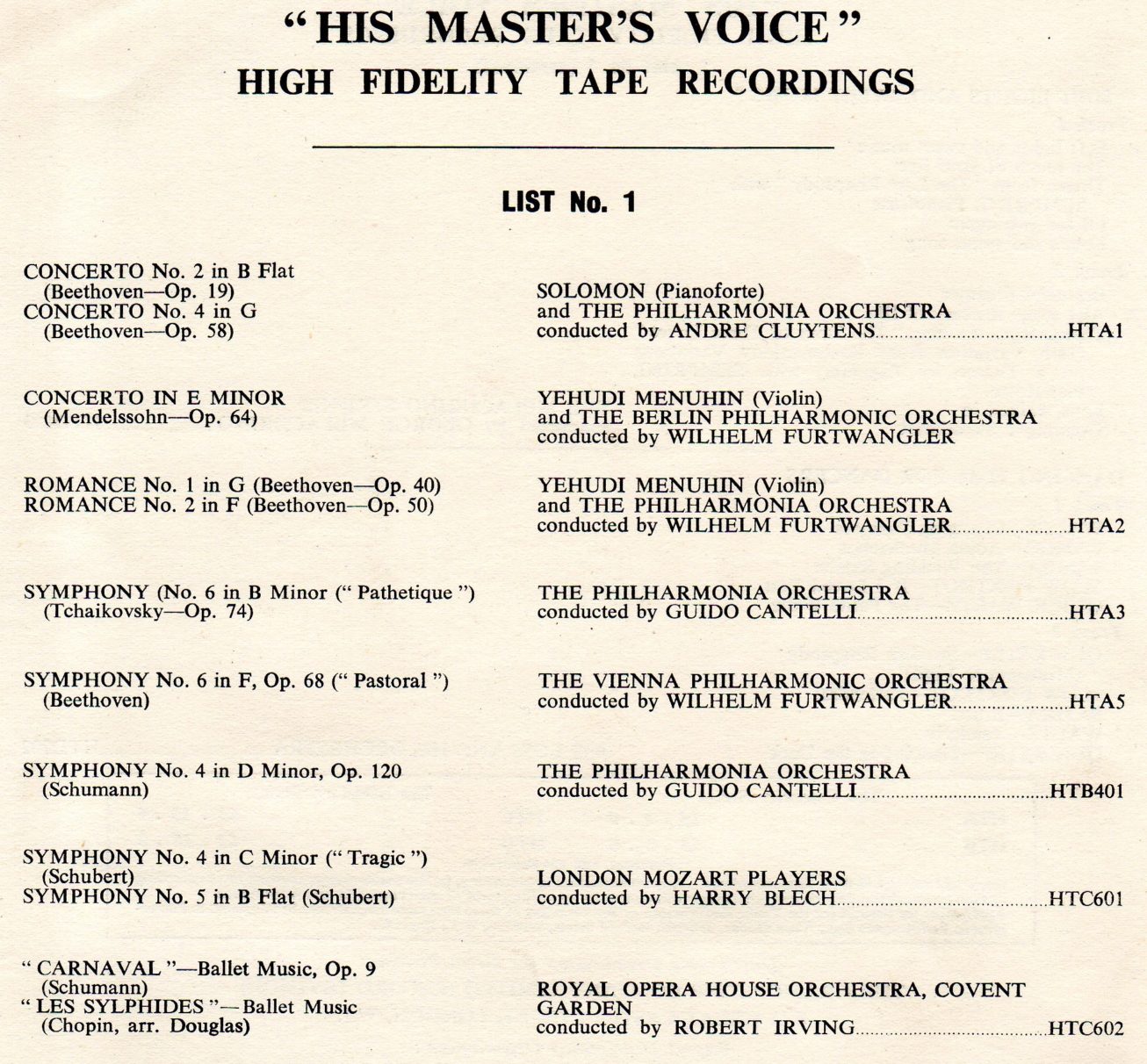
Pour la toute première de la série, référencée HTA 1, HMV a choisi ces deux concertos de Beethoven interprétés par Solomon et Cluytens, deux réalisations magnifiques où les deux musiciens ont accordé leurs conceptions à la perfection. La prise de son, très équilibrée et d’une ampleur très agréable, reflète bien l’acoustique chaleureuse de Kingsway Hall. La bande, qui date donc de 1954, est en très bon état, sauf de temps en temps (dans le concerto n°4) quelques bruits ‘électriques’ qui proviennent probablement de parasites électriques lors de la copie de la bande.

In September 1954, His Master’s Voice (HMV) published its first commercial list of pre-recorded tapes that were dubbed onto the same tape recorders used by the studios, and using the same tapes as during the recording sessions. The quality obtained is still amazing, even if the speed (19 cm/s) is only a quarter of the speed that was used (76 cm/s) during the recordings, and the only drawback is a slight tape hiss.
For the very first of the series, referenced HTA 1, HMV chose these two Beethoven concertos performed by Solomon and Cluytens, two magnificent interpretations in which the two musicians matched their views to perfection. The sound recording, very balanced and with a very pleasant fullness, reflects well the warm acoustics of Kingsway Hall. The tape, which dates from 1954, is in very good condition, except for occasional ‘electrical’ noises (in Concerto No. 4), which were probably due to electrical interferences when the tape was dubbed.


Busch Quartet: Adolf Busch & Gösta Andreasson, violin I & II; Karl Doktor, viola; Hermann Busch, cello
Beethoven Quartet n°9 Op.59 n°3 London Abbey Road Studio n°3 – 10 & 16 November 1933
Source: 33t./LP World Records Retrospect Series SH 271 (1976)
Prod: Fred Gaisberg – Engineer: Edward Fowler
Transfer & Remastering: Anthony Griffith
Pour terminer cette série, voici le troisième des quatuors ‘Rasoumovsky’.
Le Quatuor Busch l’a enregistré au Studio n°3 d’Abbey Road avec Edward Fowler, qui a supervisé tous les enregistrements du Quatuor Busch et d’ Artur Schnabel dans les années trente, et cela signifie la meilleure qualité possible tant musicale que technique.
Les reports ont été réalisés par Anthony Griffith pour son label ‘World Records’, et c’est l’assurance que le message musical contenu dans les sources utilisées, à savoir des pressages vinyl à partir des matrices métalliques 78 tours, a été entièrement préservé.

To conclude this series of posts, here is the third ‘Rasoumovsky’ quartet.
The Busch Quartet recorded it in the Abbey Road Studio n°3 with Edward Fowler, who was in charge of all the recordings with the Busch Quartet and with Artur Schnabel in the 1930s, and this means the best available musical and technical quality.
The transfers were made by Anthony Griffith for his label ‘World Records’, and this means that the integrity of the musical message contained in the sources that were used, namely vinyl pressings from the 78rpm metal parts, has been fully preserved.



